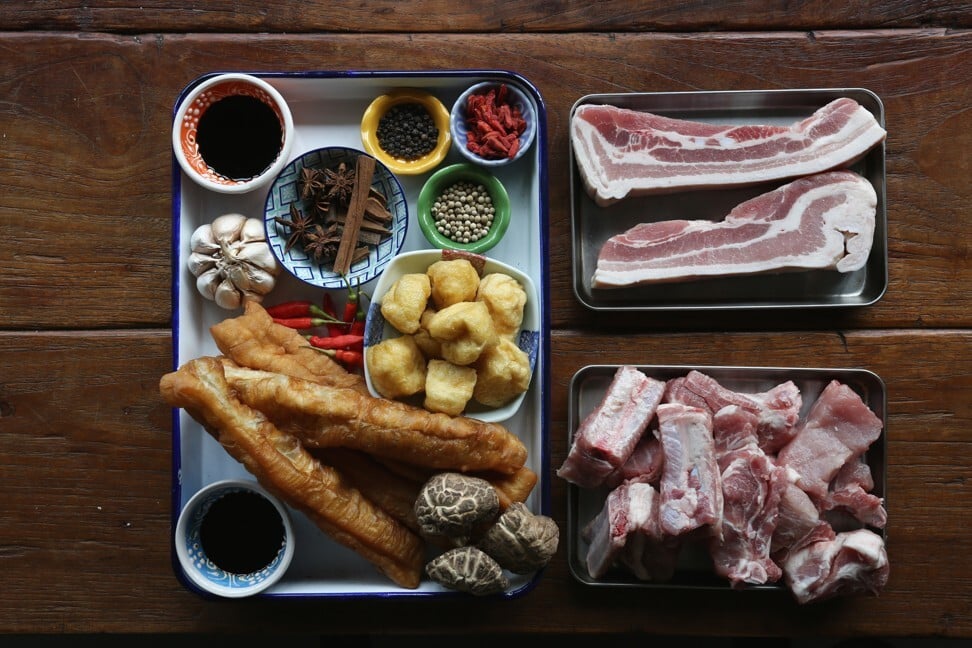
How to make Singapore-style ‘pork bone tea’, or bak kut teh, using a multicooker
- Don’t have a pressure cooker? This recipe can also be made in a regular pot on the stovetop
- Singapore-style bak kut teh uses white and black peppercorns and is much hotter than the herby Malaysian variety
I’m late to the game, but I’ve finally acquired a smart multicooker, which many people call an Instant Pot even if the device is not by that particular manufacturer (it is not available in Hong Kong). It’s designed to be an all-in-one electric cooker that can do everything, from sous-vide to slow-cook, sauté and pressure cook. Depending on the brand, it might also have settings for yogurt, rice, porridge, cake and even dried abalone.
I have a stovetop pressure cooker, which I use often, but I’ll admit the pressure-cooker setting on the multicooker seems a lot safer. With the stovetop version, I’m always listening for the whistling from the valve warning me it’s at maximum pressure, which means I need to lower the flame. Occasionally, I lower the heat too much and the pressure drops so far I might as well be using a regular pan.
Singaporean-style bak kut teh
The Singaporean and Malaysian versions of bak kut teh (“pork bone tea”) are very different. The former is strong, almost hot, with pepper, especially white pepper, while the latter is fragrant with Chinese herbs and spices. I love both, but it’s easier to find the ingredients for the Singaporean style in Hong Kong, so that’s what I’ve made. It’s the perfect dish to make in a multicooker.
I use whole peppercorns and grind them myself because the flavour is better than the pre-ground version. This recipe is quite peppery, and if you want it milder, use only two teaspoons of white peppercorns. Cassia bark is often labelled as cinnamon, even though it is not the same. True cinnamon is thin and easy to break into pieces using just your fingers, while cassia bark is thicker and harder.
Put the pepper, cassia bark and star anise into a spice bag (which looks like a tea bag) large enough for the spices to swim – if the bag is too small, they won’t release their flavour. Be sure to secure the top of the bag with twine, or the spices (especially the crushed pepper) might escape.
Broths made in a pressure cooker are clearer than those made conventionally, which need to be skimmed to remove impurities. I still like to blanch the bones first, though, which adds a step (and about 10 minutes) to the process. I do this in a regular pot rather than the multicooker, because by the time you heat it, cook briefly, then let it cool sufficiently to open the lid, you don’t save any time.
If you use a stovetop pressure cooker, which has higher pressure than a multicooker, cook the bak kut teh for about 30 minutes in total. I’ve also given instructions on how to make this in a regular pot.

600 grams pork ribs, cut into 6cm pieces
350 grams pork belly
1 tbsp whole white peppercorns
1 tsp whole black peppercorns
2 star anise
1 stick (7.5cm) of cassia bark
1 whole head of garlic
8 dried Chinese mushrooms, each about 3cm in diameter
10ml light soy sauce
10ml fish sauce
Fine sea salt, as necessary
10 grams goji berries
8 fried bean curd puffs
To serve:
Light soy sauce
Red bird’s-eye chillies
2 pairs yau ja gwai (Chinese fried doughnut sticks)
Steamed white rice
1 Cut the pork belly into five or six pieces. Rinse the pork ribs and pork belly under cool running water, then put them in a large pot. Add boiling water to cover the meat by about 3cm, then bring to a boil over a high flame. Simmer for about two minutes, then drain. Rinse the meat with cool running water, then place it into the multicooker pot.
2 Finely crush the white and black peppercorns into almost a powder, either in a mortar or a spice grinder. Put the crushed pepper in a filter bag with the cassia bark and star anise, secure the bag with twine and place into the multicooker pot.

3 Remove the outer layers of skin from the garlic, leaving the cloves attached at the base. Rinse the mushrooms under running water.
4 Put the garlic and mushrooms into the pot with the pork and spices, then add the soy sauce, fish sauce, five grams of salt and 1.8 litres of boiling water. Put the pot in the multicooker, close the lid and, using the pressure-cooker setting, cook for 30 minutes. (If cooking on the stove, bring to a boil, partially cover with a lid, then lower the flame and simmer for an hour. Occasionally skim the surface to remove impurities.)

5 After 30 minutes, quick-release the pressure. Remove the lid and add the goji berries and bean curd puffs (cut in half). Close the lid and pressure-cook for another 10 minutes. (If cooking on the stove, add the goji berries and bean curd puffs, then simmer for another 30 minutes, or until the ribs are tender.)
6 Quick-release the pressure on the multicooker. Taste the broth and add more salt, if necessary.
7 Finely mince a few bird’s-eye chillies and divide them between four to six small sauce dishes, adding soy sauce to each.
8 If the yau ja gwai are soft, heat them for about five minutes in an oven that’s been preheated to 180 degrees Celsius. Cut them into 2.5cm pieces.
9 Ladle the bak kut teh broth into four to six individual serving bowls, adding portions of ribs and pork. Serve with hot rice, the yau ja gwai and the chilli soy dipping sauce for the meat.

